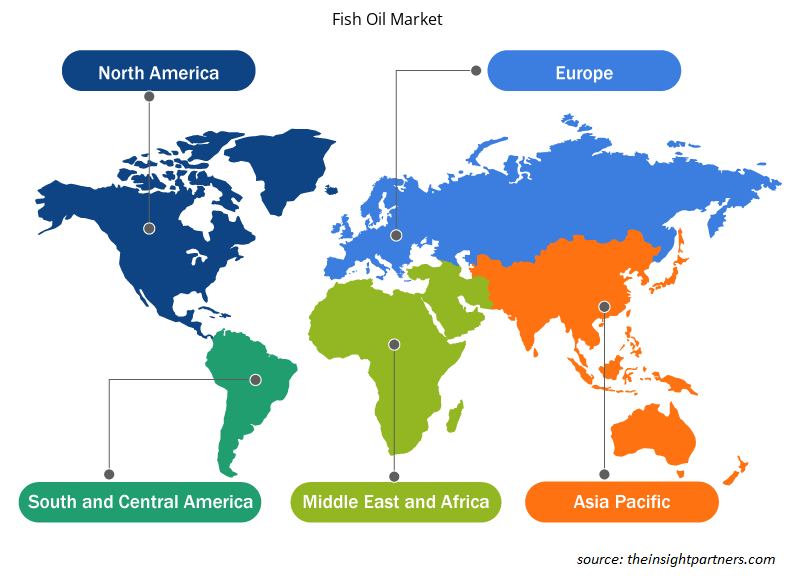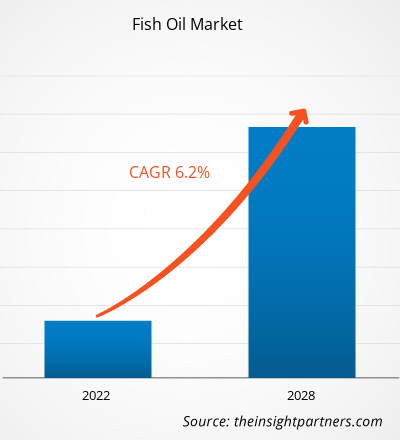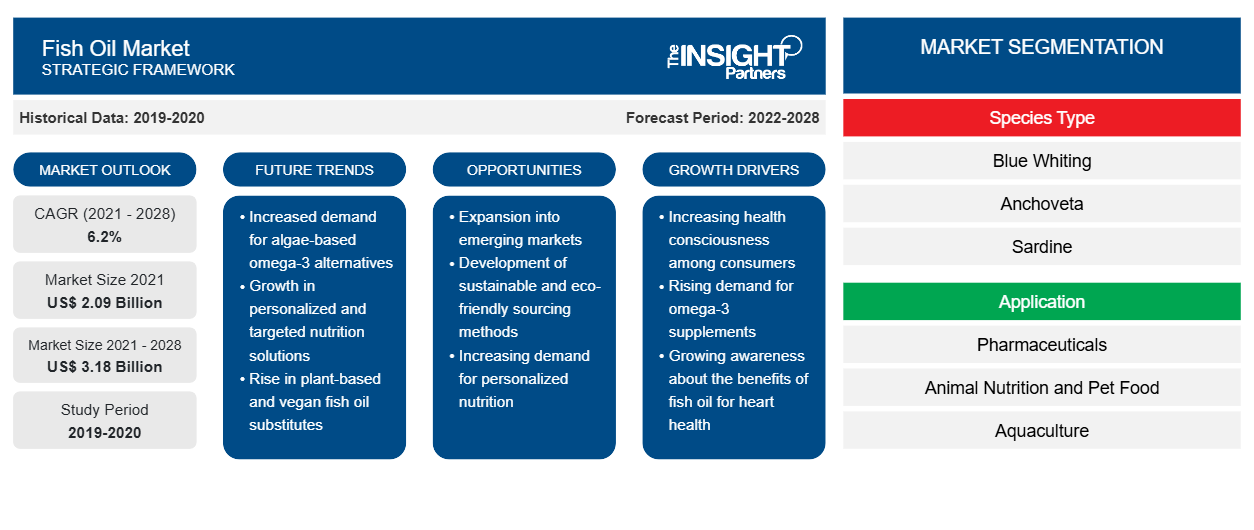Il mercato dell'olio di pesce è stato valutato a 2.087,39 milioni di dollari nel 2021 e si prevede che raggiungerà i 3.178,28 milioni di dollari entro il 2028. Si prevede che crescerà a un CAGR del 6,2% dal 2021 al 2028.
L'olio di pesce è ricavato dai tessuti di varie specie di pesci e contiene acidi grassi omega-3, come gli acidi eicosapentaenoici (EPA) e docosaesaenoici (DHA). Offrono vari benefici per la salute, tra cui un rischio ridotto di morte per infarto, pericolosi ritmi cardiaci anormali, trigliceridi abbassati e ictus.
Nel 2020, l'Asia Pacifica ha dominato il mercato globale dell'olio di pesce e si prevede che manterrà il suo predominio durante il periodo di previsione. La crescente consapevolezza relativa ai benefici per la salute e al ricco profilo nutrizionale dell'olio di pesce sta guidando la crescita del mercato dell'olio di pesce in tutta la regione. Insieme a questo, la maggiore prevalenza di malattie croniche in vari paesi della regione sta portando a una maggiore domanda di olio di pesce. Ad esempio, in Australia, si stima che il cinquanta percento degli australiani abbia almeno 1 delle 8 condizioni croniche comuni selezionate: cancro, malattie cardiovascolari, condizioni di salute mentale, artrite, mal di schiena e problemi, malattia polmonare ostruttiva cronica, asma e diabete. Si prevede che questi fattori favoriranno la crescita della domanda di olio di pesce in tutta la regione.
Personalizza questo report in base alle tue esigenze
Riceverai la personalizzazione gratuita di qualsiasi report, comprese parti di questo report, o analisi a livello nazionale, pacchetto dati Excel, oltre a usufruire di grandi offerte e sconti per start-up e università
-
Scopri le principali tendenze di mercato in questo rapporto.Questo campione GRATUITO includerà analisi di dati che spaziano dalle tendenze di mercato alle stime e alle previsioni.
Approfondimenti di mercato
Ampia gamma di applicazioni dell'olio di pesce in diversi settori
L'olio di pesce è sempre più utilizzato in vari settori, come quello farmaceutico, degli integratori alimentari , della nutrizione animale e del cibo per animali . Trova un'applicazione significativa nei prodotti farmaceutici ed è considerato olio naturale o concentrati di EPA-DHA. È anche utilizzato per l'alimentazione animale in quanto fornisce effetti di promozione della crescita ed è una fonte di energia poco costosa. Oltre a questo, è anche utilizzato nel cibo per animali e aiuta a rafforzare il sistema immunitario dei cani, mentre aiuta anche a combattere il cancro canino. L'olio di pesce è anche utilizzato come integratore alimentare in cui le capsule sono tradizionalmente realizzate utilizzando gelatina che ricopre l'olio nelle capsule soft-gel. Pertanto, l'utilizzo dell'olio di pesce in diversi settori sta guidando la crescita del mercato dell'olio di pesce.
Approfondimenti sul tipo di specie
In base al tipo di specie, il mercato dell'olio di pesce è diviso in melù, acciuga, sardina, capelin e altri. Nel 2020, il segmento delle sardine è stato quello in più rapida crescita nel mercato. La sardina è un piccolo pesce simile all'aringa con vari benefici nutrizionali simili ad altri pesci come il salmone. L'olio estratto dalla sardina è anche usato come lubrificante e viene utilizzato principalmente in vernici, vernici, biocarburanti e linoleum.
Pesquera Exalmar SAA; Omega Protein Corporation; Pelagia AS; Copeinca; Coplex International SAC; Triplenine; FF Skagen A/S; DSM; Croda International PLC; e BASF SE sono i principali attori che operano nel mercato dell'olio di pesce. I principali attori adottano diverse strategie, come fusioni e acquisizioni e lanci di prodotti, per espandere la loro presenza geografica e la base di consumatori.
Segnala i riflettori
- Tendenze progressive nel settore dell'olio di pesce per aiutare i giocatori a sviluppare strategie efficaci a lungo termine
- Strategie di crescita aziendale adottate dalle aziende per garantire la crescita nei mercati sviluppati e in via di sviluppo
- Analisi quantitativa del mercato globale dell'olio di pesce dal 2019 al 2028
- Stima della domanda di olio di pesce nei vari settori industriali
- Analisi di Porter per illustrare l'efficacia degli acquirenti e dei fornitori che operano nel settore nel prevedere la crescita del mercato
- Sviluppi recenti per comprendere lo scenario competitivo del mercato e la domanda di olio di pesce
- Tendenze e prospettive del mercato, insieme ai fattori che guidano e frenano la crescita del mercato dell'olio di pesce
- Comprensione delle strategie che sostengono l'interesse commerciale in relazione alla crescita del mercato globale dell'olio di pesce, aiutando nel processo decisionale
- Dimensioni del mercato dell'olio di pesce nei vari nodi del mercato
- Panoramica dettagliata e segmentazione del mercato globale dell'olio di pesce nonché delle sue dinamiche di settore
- Dimensioni del mercato dell'olio di pesce in varie regioni con promettenti opportunità di crescita
Approfondimenti regionali sul mercato dell'olio di pesce
Le tendenze regionali e i fattori che influenzano il mercato dell'olio di pesce durante il periodo di previsione sono stati ampiamente spiegati dagli analisti di Insight Partners. Questa sezione discute anche i segmenti e la geografia del mercato dell'olio di pesce in Nord America, Europa, Asia Pacifico, Medio Oriente e Africa e America meridionale e centrale.

- Ottieni i dati specifici regionali per il mercato dell'olio di pesce
Ambito del rapporto sul mercato dell'olio di pesce
| Attributo del report | Dettagli |
|---|---|
| Dimensioni del mercato nel 2021 | 2,09 miliardi di dollari USA |
| Dimensioni del mercato entro il 2028 | 3,18 miliardi di dollari USA |
| CAGR globale (2021 - 2028) | 6,2% |
| Dati storici | 2019-2020 |
| Periodo di previsione | 2022-2028 |
| Segmenti coperti |
Per tipo di specie
|
| Regioni e Paesi coperti |
America del Nord
|
| Leader di mercato e profili aziendali chiave |
|
Densità degli operatori del mercato dell'olio di pesce: comprendere il suo impatto sulle dinamiche aziendali
Il mercato dell'olio di pesce sta crescendo rapidamente, spinto dalla crescente domanda degli utenti finali dovuta a fattori quali l'evoluzione delle preferenze dei consumatori, i progressi tecnologici e una maggiore consapevolezza dei benefici del prodotto. Con l'aumento della domanda, le aziende stanno ampliando le loro offerte, innovando per soddisfare le esigenze dei consumatori e capitalizzando sulle tendenze emergenti, il che alimenta ulteriormente la crescita del mercato.
La densità degli operatori di mercato si riferisce alla distribuzione di aziende o società che operano in un particolare mercato o settore. Indica quanti concorrenti (operatori di mercato) sono presenti in un dato spazio di mercato in relazione alle sue dimensioni o al valore di mercato totale.
Le principali aziende che operano nel mercato dell'olio di pesce sono:
- PESQUERA EXALMAR SAA
- CORPORAZIONE DI PROTEINE OMEGA
- PELAGIA COME
- COPPAINCA
- COPLEX INTERNAZIONALE SAC
Disclaimer : le aziende elencate sopra non sono classificate secondo un ordine particolare.

- Ottieni una panoramica dei principali attori del mercato dell'olio di pesce
"Global Fish Oil Market Analysis to 2028" è uno studio specializzato e approfondito del settore alimentare e delle bevande con un'attenzione particolare all'analisi delle tendenze del mercato globale dell'olio di pesce. Il rapporto mira a fornire una panoramica del mercato con una segmentazione dettagliata del mercato. Il mercato dell'olio di pesce è analizzato su tre fronti: tipo di specie, applicazione e geografia. In base al tipo di specie, il mercato è suddiviso in melù, acciughe, sardine, capelin e altri. In base all'applicazione, il mercato dell'olio di pesce è suddiviso in prodotti farmaceutici, nutrizione animale e cibo per animali domestici, acquacoltura, integratori alimentari e altri. In base alla geografia, il mercato dell'olio di pesce è segmentato in cinque regioni principali: Nord America, Europa, Asia-Pacifico, Medio Oriente e Africa e Sud e Centro America.
Profili aziendali
- BASF SE
- Copeinca
- Coplex SAC Internazionale
- Croda International PLC
- Il DSM-5
- FF Skagen A/S
- Società proteica Omega
- Pelagia AS
- Pesca Exalmar SAA
- Triplo nove
- Analisi storica (2 anni), anno base, previsione (7 anni) con CAGR
- Analisi PEST e SWOT
- Valore/volume delle dimensioni del mercato - Globale, Regionale, Nazionale
- Industria e panorama competitivo
- Set di dati Excel
Report recenti
Rapporti correlati
Testimonianze
Motivo dell'acquisto
- Processo decisionale informato
- Comprensione delle dinamiche di mercato
- Analisi competitiva
- Analisi dei clienti
- Previsioni di mercato
- Mitigazione del rischio
- Pianificazione strategica
- Giustificazione degli investimenti
- Identificazione dei mercati emergenti
- Miglioramento delle strategie di marketing
- Aumento dell'efficienza operativa
- Allineamento alle tendenze normative























 Ottieni un campione gratuito per - Mercato dell'olio di pesce
Ottieni un campione gratuito per - Mercato dell'olio di pesce